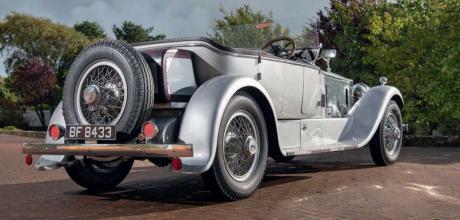Swedish-bodied 1921 Rolls-Royces Silver Ghost
One of the most engaging things about many Rolls-Royces is their story – the ups and downs of a long and interesting life. This rare Swedish-bodied 1921 Silver Ghost is no exception, with a tale that takes in Stockholm, Switzerland and now Scotland.
WORDS: NIGEL BOOTHMAN
PHOTOS: ADEBRANNAN / JAN SEGERFELDT / TONY PETERS
SWEDISH EXOTICA — GORGEOUS GHOST SWEDISH-BUILT PHAETON
A bold buy and careful restoration fulfils a dream
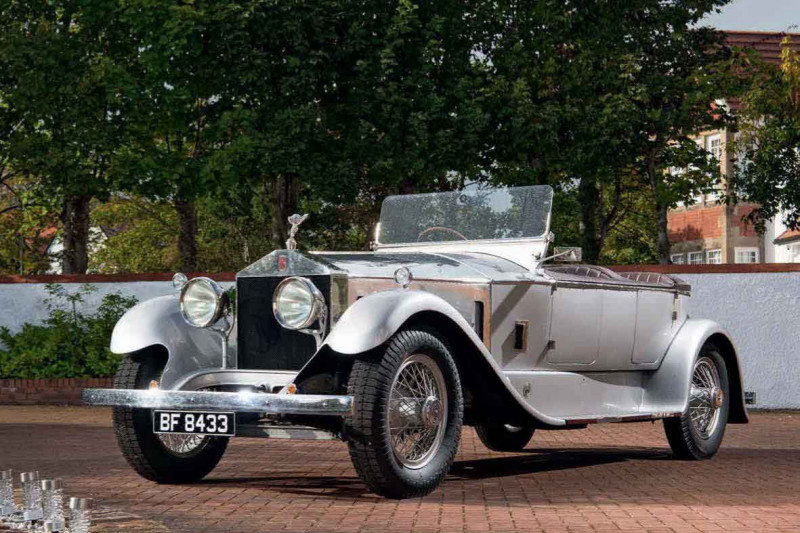
‘Silver Ghosts were always dream cars for me,’ says Tony Peters. ‘Out of reach in any condition.’ It’s something most car fans have to face. You dream of owning a certain model, but you don’t dream too hard because you know it’s just not realistic. Short of a lottery win or another unusual piece of luck, dreams remain dreams, sadly divorced from reality. Tony, however, had one of those pieces of luck. Or rather he had a lucky opportunity and unlike the majority of us, he had the gumption to act on it. ‘It was six years ago, May 2017. I had owned a 20hp shooting brake when I was in my twenties and always regretted selling it. I’m now 71 and although I’ve had various Silver Shadows, Bentley Ts, Spirits and a Seraph, I fancied another “Twenty”, but this time with an open-top, and began keeping an eye out. Which is why I was looking at the auction catalogue at the Spa Classic.’
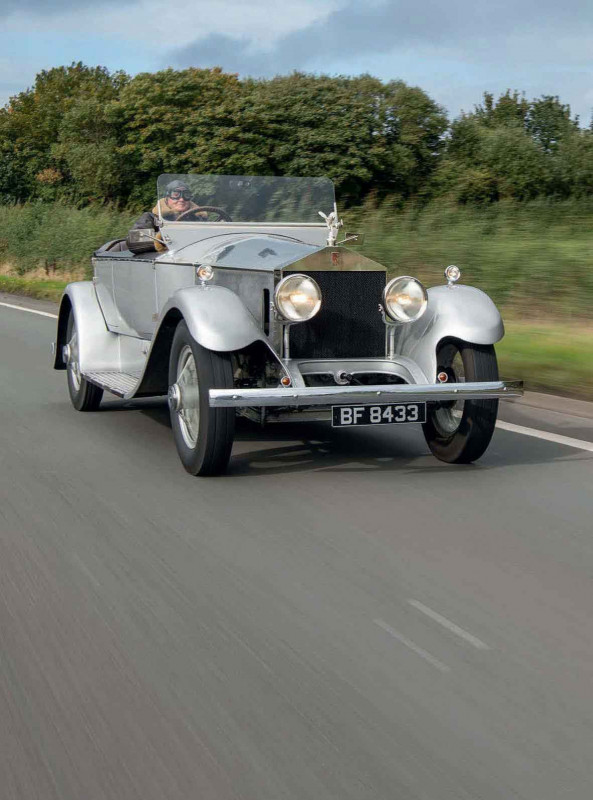
Tony was attending the Spa Classic at the Francorchamps F1 circuit to watch old cars race rather than buy them, but then he noticed two old Rolls-Royces in amongst lots of younger, flashier machines in the Bonhams’s sale – a Phantom II and a Silver Ghost. ‘The Ghost was offered with no history, no paperwork, no battery, no fuel, not even any certainty that it would go,’ says Tony. ‘But it was a nice-looking, intact car and certainly no wreck. It was offered at no reserve, and it was clearly in the wrong sale. I was the right guy in the right place at the right time.’ How much? We won’t mention a figure, but if we tell you Tony bought his Silver Ghost for the price of a nice but not exceptional 20hp tourer, you’d agree he did pretty well. However, as you’ll know if you’ve ever bought an old car in less than perfect condition, this is just where the spending begins. But before we get into the adventures Tony has had in reviving his Ghost, let’s examine what he bought.
DERBY, PARIS… STOCKHOLM?
Chassis 33NE is an O-series car that went on final test on January 11th 1921 and was probably sent to the French Rolls-Royce distributor in Paris, either for their showrooms or because they were acting as middlemen for the export to the car’s final destination. For all of the detail in the car’s early history, we’re indebted to Jan Segerfeldt, a Swedish author and historian who has published a book on all the Rolls-Royce and Bentley cars registered in Sweden between 1911 and 1965 — Rolls-Royce Världens bästa bil i Sverige 1911-1965. Mr Segerfeldt wrote to Tony after hearing from Per Östlund, Chairman of the RREC’s Swedish section, that Tony was keen to find out more about 33NE’s early days. There’s a lot of conjecture about the car’s creation, and it may even have been to Paris in spirit only – Jan Segerfeldt wonders if it was a cancelled order, and in fact went directly to Stockholm. Either way, it wound up with Aktiebolaget A. Wiklunds (the first word is approximately the same as our ‘Limited’), who were the Rolls-Royce sole concessionaire for Sweden.
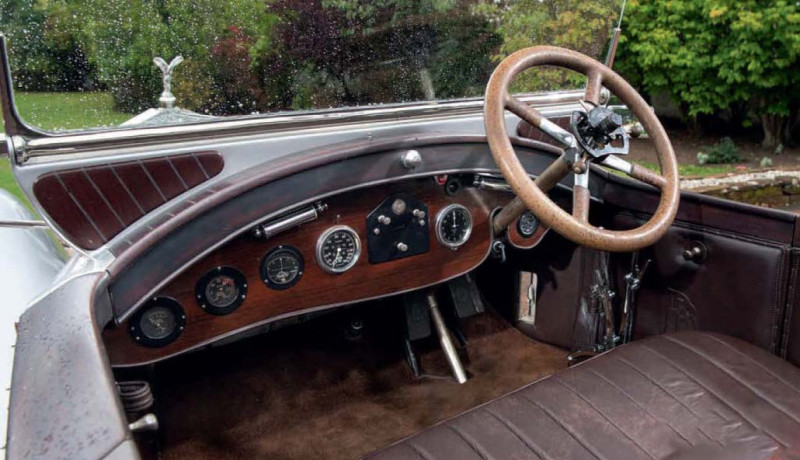
At this point, it’s possible the car had already been bodied elsewhere, but it seems more likely that it received an open dual-cowl phaeton body built by Nordbergs. It was then sold to to Knut Johansson, MD of a company called Aug Holst Päls-och Mössfabrik, and registered A235. Only three years later in 1924, the car was rebuilt with new or heavily amended coachwork in a grander cabriolet de ville style, as shown in the two old photographs Jan was able to find for his book, and which are reproduced here. A substantial folding roof, supported by pram irons, featured a lighter roll-up section over the front seat to allow a sedanca-type look. Large, framed side windows completed an impressive all-weather body. This approach of re-bodying an older chassis with new, more fashionable coachwork was common enough at the time and especially popular in Sweden, says Jan. Indeed, some cars were even re-tested and given new model years, which causes confusion nowadays.
Chassis 33NE had more return visits to Nordbergs than planned, including an accident in 1930 reported in the local paper that left both front wings and one rear wing badly damaged. Whether the owner elected to have any further updates built into the repairs at this point isn’t known, but it seems unlikely as the car remained a cabriolet de ville during subsequent ownership. In 1946 it was sold to Captain / Consul Sven Jeansson, then in 1950 to Sven du Rietz and eventually to Ralf & Joran Lagne, once again in Stockholm, who kept it from 1956 to 1997 and modified the body once again – of which more, later.
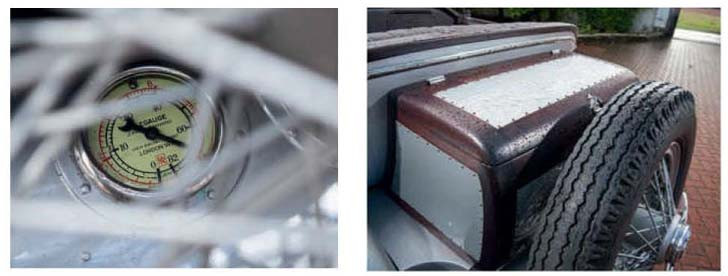
It found its way to the UK in 1997 where it sold at auction to Rolf Erb, a wealthy Swiss entrepreneur. He apparently never drove it, which explains its somewhat museum-like state when Tony acquired it. The sale in 2017 included the ‘Swiss Castle’ collection, the castle in question being Eugensberg, Erb’s home. Out of this dissolution many cars found new homes, and indeed returned to the road where we could all enjoy seeing them. Or rather, 33NE returned to the road after some dedicated efforts from the new owner.
MINOR DISASTER
Tony says Bonhams did a very professional job of storing and then transporting the car to UK, also handling the tax payment required to remove it permanently from Switzerland. It arrived in London with no registration document, but with a duplicate of a Swiss document that should have sufficed. Then the DVLA decided they wanted to inspect it, but on doing so, couldn’t find the engine number. Once this had been located and all the to-and-fro bureaucracy negotiated, it was six months after the sale before the Ghost was registered in the UK. Tony brought it home to south-west Scotland and persuaded it to run. The magnificent Rolls-Royce carburettor responded after a bit of cleaning and adjustment, but it was supposed to take its supply of fuel from a small head of air pressure created by a hand-pump, and this was disconnected, so Tony installed a small low-pressure electric pump in the fuel line instead, which he says runs fine and gives no trouble… though he keeps a spare in the car!
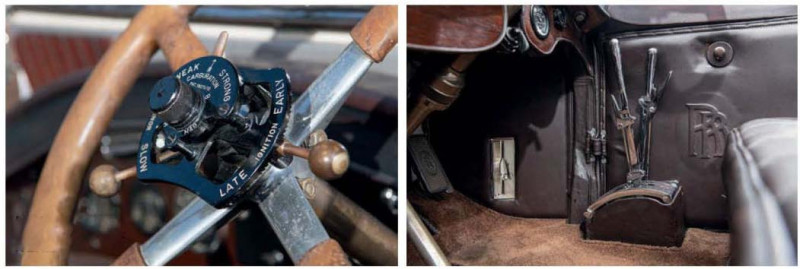
The brakes and various other moving parts were checked, lubricated and restored to full working order, and before long Tony had the car on the road, and without significant extra investment. Too good to be true? Well, yes. ‘I was out with it one day in November 2019 when the engine seized,’ says Tony. ‘The oil pump drive had sheared, starving the crankshaft of lubrication. I didn’t see the oil pressure gauge drop because I had half the front tonneau fitted.’
In fact, only one main journal had been damaged, but because they’re white metal rather than off-the- shelf shell bearings, Tony had to get all seven mains re-done by Fiennes and line-bored at once, costing a painful £8500 plus VAT. ‘It was a sore one,’ says Tony, ‘but it gave me the chance to inspect everything else and fit an upgraded oil pump drive. The oil pump is outboard of the engine, and it takes a square peg-drive from the bottom of the distributor. The shaft split and opened up at one side. The Silver Ghost Association of America manufacture and supply a modified and beefedup oil pump drive section which I recommend all Ghost owners should fit. This new one will not fracture! I found I could get most bits from the Silver Ghost Association in the USA, as well as through a few specialists in the UK.’
This also prompted the fitting of an oil level sight glass which attaches to a modified sump plate and an oil filter assembly, both of which can be obtained from the SGA in America. But more importantly, and to avoid the same scenario happening again, Tony made up an audible and visual warning system to alert the driver if and when the oil pressure drops below 5psi by adding a low pressure switch to the oil pressure system that sounds a high-pitched alarm and illuminates a red LED light right in the middle of the dashboard. He is proud to say that the SGA of America has adopted this very system, which can be bought from them at a very reasonable cost – another must for all Ghost owners! Tony took the chance to fit a Gear Vendors overdrive unit, comfortably extending the car’s cruising speed from ‘about 48mph’ to ‘about 58mph’, which is ideal for covering a bit of distance across country. He resisted any further changes to the Rolls-Royce mechanical specification, but he found plenty to do with the body. Not least, it was time to devise a method of keeping the rain off.
RAISING THE ROOF
The second Nordbergs body may have been suffering the ravages of time (and more than 30 Swedish winters), or it may just have been seen as too heavy to get the best from the car. Whatever the reason, it seems it was modified quite radically by the final Swedish owners, two brothers who kept the car for 40 years. ‘They cut the cabriolet body off at the waistline,’ says Tony, ‘So from the door tops down it’s essentially the same body. But they were boatbuilders – that was part of their business, Atlas Copco – and they added the timber cappings as a solution to the problem of what to finish the doors and body panels with, once the windows and hood arrangement were removed. They also had the body right off, painted the chassis and so on. But although they got it all back together, one of the brothers died before it was quite finished, and his son arranged its sale in the UK in 1997.’ Whether the gentleman had planned to create a folding roof for the car, or just run it as a sunnyday open tourer, it left Tony with something of a conundrum. Can you really live anywhere in the UK and enjoy an old car to the full without provision for wet weather? It seemed logical to find a solution at the same time as the cosmetic restoration to the rest of the coachwork.
Tony wasn’t happy with the network of microblisters, chips and cracks in the silver paint, so he dismantled the body entirely, stripped it back and re-painted it. Doors off, windscreen off, wood cappings masked off and everything back to bare metal. The new finish is stunning; just the right mix of sleek, reflective smoothness without the over-glossy, almost wet shine of modern paint. The wood is remarkable too, with the newer pieces Tony used around the base of the screen and the dash blending beautifully with the other cappings. The whole effect is indeed very like a gentleman’s motor launch – once you see the car in the flesh you can almost picture it taking to the waters of Lake Como and cruising sedately into the distance. Back to that clever roof. Tony’s engineering experience led him to devise a unique approach that leaves the dry-weather look of the car unaltered, with no great pile-up of folded frame and fabric behind the back seat. Instead, the car relies on a push-together frame of stainless steel that rests on fitted stainless saddles, themselves wrapping over the wooden cappings in four places. The roof fabric drops over this, and indeed the whole constriction can be lifted on or off in one piece. For touring or trips away, Tony stores the frame pieces behind the spare wheel and the fabric in the trunk. The roof itself, incidentally, was made to measure by a sailmaker pal of Tony’s in an authentic black mohair-type fabric.
A LIFE OF ADVENTURE
With the car well and truly sorted, Tony has been able to enjoy it not just on local roads but further afield, including participation in some amazing events. Most notable of these was the 2021 re-enactment of the London to Edinburgh Trial, held in 1911. This, as many readers will know, originated from a challenge laid down by Napier. They were, at the time, seen as Rolls- Royce’s chief rival. Someone at Napier came up with original idea of a drive from London to Edinburgh in top gear alone, followed by a timed speed test. This was indeed completed, under the watchful eye (and gear-locking tabs) of the RAC, with a 65hp Napier averaging 19.35mpg and hitting 76.42mph when let off the leash. Claude Johnson, very much the public promoter of Rolls-Royce with Henry Royce so much happier behind the scenes, decided to submit a light touringbodied 40/50hp, Silver Ghost 1701, to the same test. He selected Ernest Hives to drive it, confident that Hives would get the best from the car, which he did: 24.32mpg and 78.26mph. A memorable victory for Rolls-Royce. In September 2021, on the 110th anniversary of the run, Rolls-Royce sent 1701 up the road again on as much of the same route as can still be driven. Only this time, it was accompanied by nine other 40/50hps from the 20-Ghost club, one of which was Tony’s car. ‘All ten Ghosts started and finished without any breakdowns or malfunctions,’ says Tony. ‘All cars returned an average fuel consumption of 14 mpg, probably because we could drive faster on modern roads, which gets you places but burns more fuel. The actual gear shift lock plate which the RAC fitted to all the cars can be seen next to the gear shift of this car. This was to prohibit the use of all forward gears except top gear. Only neutral, reverse and top could be selected.’
It says plenty for the engine’s remarkable flexibility and indeed the integrity of the clutch that such a thing was possible now, never mind then. But the 40/50hp Silver Ghost did more than set standards for luxury; it defined what a car should be capable of for decades to come. The fact that a design getting on for 120 years old, with all but the youngest examples now centenarians, can still travel comfortably at the speed of the traffic on modern roads is mind-boggling. Does it take a great deal of concentration?
‘You just think ahead,’ says Tony. ‘That’s mainly because the braking is so different from new cars. There is one large outer drum on each rear wheel for the foot brake and an inner drum for the parking brakes, but you can use both to stop a little more smartly. Everything feels balanced and nicely engineered, and it does work. The ride is very comfortable but it’s a big, heavy car and hard to manoeuvre, so I end up doing eight-point turns.
But it’s lovely once it’s going, and nicer still with the roof on, because there’s so much wind otherwise. I tend to wear a helmet and goggles.’ Tony has even taken the car back to Sweden for a visit to where Nordbergs had been, and then to the site of the original dealer, Wiklunds. He was able to link this up with an RREC Swedish Section tour on Åland island, north of Stockholm in the summer of 2022.
This surely brings the story of this magnificent car full circle, from its creation as high-luxury transport in a foreign land to a return to the country of its birth, and resurrection to the kind of use for which it was meant. We were delighted to see Tony and the car at Burghley House for this year’s annual rally, and while he admitted to covering the motorway distance with the car on a trailer, it’s still gathering the miles under its belt – and at a decent clip, as you can see from our photos. It would be easy to end with something about dreams coming true, or nice things happening to good people, but the real lesson is this: be ready and willing to act on a great chance if it ever appears. And for all those who think a Ghost is out of reach (and I’m one of them!), then maybe, just maybe, we could have one too.
THANKS TO: Jan Segerfeldt, whose book can be bought online at bokus.se or adlibris.se
“The ride is very comfortable but it’s a big, heavy car and hard to manoeuvre, so I end up doing eight-point turns.”
Large wheels and rear wings contribute to Ghost's distinctive look. Rolls-Royce carburettor, now fed by an electric pump. External spin-on oil filter is a wise modern modification, sold by the Silver Ghost Association in America. Photographer Ade Brannan's amazing 'ghosted' image makes bonnet transparent.
“The ride is very comfortable but it’s a big, heavy car and hard to manoeuvre, so I end up doing eight-point turns.”
Large wheels and rear wings contribute to Ghost's distinctive look. Plenty to keep the driver occupied, but it all works well Yacht-like timbers cap the doors and upper edges of the body Tony had highly accurate coachbuilder's plate made up from old photos.
“The whole effect is indeed very like a gentleman’s motor launch – once you see the car in the flesh you can almost picture it taking to the waters of Lake Como and cruising sedately into the distance.”
Capacious trunk is finished with timber. Fuel gauge on tank — better than nothing! edging to match car perfectly
Disaster! The split oil pump drive that cost Tony an engine rebuild Red warning light and audible alarm means no more oil pressure disasters.
“It was offered at no reserve, and it was clearly in the wrong sale. I was the right guy in the right place at the right time.”
Body in bare metal as Tony gets ready to paint the car. Another view of the fittings used to work out the roof frame. The whole frame can be lifted off the car in one go The roof has good-sized side windows for a view out The new roof frame, worked out with copper piping first.
The best view of 33NE's cabriolet de ville bodywork, post-1924
Tony's car is the one in the background.
Tony, happy at the wheel, despite a damp photoshoot!


